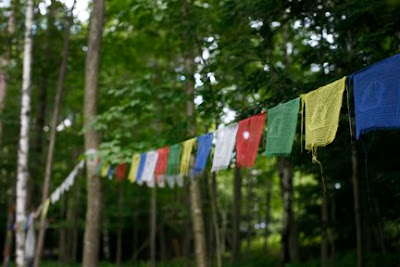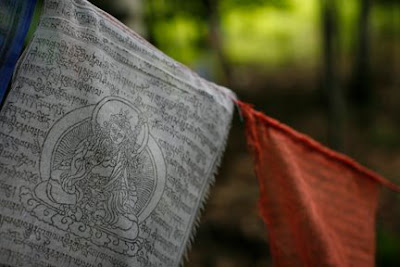This weekend’s workshop was with Doug Beasley, founder of Vision Quest Photo Workshops. He has been leading these workshops since 1992 – ranging in length and location. Doug’s work focuses on the sacred nature of every person, place, and thing. His book, Japan: A Nisei’s First Encounter, documents his first journey to Japan, his mother’s homeland. He is planning a second trip in the fall where he will be able to spend 3 weeks traveling the country.
Doug is based in St. Paul, Minnesota, but also has a cabin in north Wisconsin. Clearly because he’s from the Midwest he is a really great person to be around =) From the moment he came into CPW he seemed very comfortable, calm, and friendly.
We began the workshop with introductions and a short morning meditation. Being completely new to any sort of meditation, those 7 minutes felt like much longer. The rest of the morning was spent doing a variety of written and photographic exercises. He encouraged us to try to photograph and think out of our element. One exercise asked us to work on developing a personal connection to the subject. Here are my results of two of them:


 (I walked past these little berries the other day and noticed that they are now all sort of reds, purples, blues, and greens! I’ll have to photograph them again soon…)
(I walked past these little berries the other day and noticed that they are now all sort of reds, purples, blues, and greens! I’ll have to photograph them again soon…)I came across Larry, a CPW Staff Member, connecting with a crack in the driveway next to CPW. I think he is crouched down in 90% of my photos from this weekend! Behind him is my fellow intern, Nikki…connecting with…the street sign?

After this we were instructed to go out and break our photographic habits. Doug gave us many suggestions, but the one that stuck with me was to “not take it so seriously, just have fun.” I tend to really think about most of the images I take. Coincidentally at this point, Nikki and I ran into Larry, who suggested a new way of ‘shooting from the hip.’ Instead of keeping our cameras at the same spot, we set them on auto and shot (somewhat) aimlessly at different angles and perspectives while walking from CPW down to the flea market. Here are a few of my favorite shots in succession:



“To live a creative life, we must lose out fear of being wrong.”
-Joseph Chilton Pierce
We then were able to revert to our more comfortable ways. We were supposed to spend a lot of time with the subject until we felt like we could photograph it to its fullest extent. Here is my shot:

After lunch we headed to Overlook Mountain and the KTD Monastery. We walked down to the Dharma Path trailhead where we began a very slow, deliberate, walking meditation down to the pond at the bottom.

The path was lined with strings of prayer flags anchored to trees. I’m not entirely sure the meaning of them or their placement, but they were really interesting.


We then gathered near the pond and learned about light and shadow. Clearly, this part of the day was really stressful…
The next morning, we did an exercise where we went from a broad picture and slowly eliminated elements. I photographed a number of different scenes, but was most interested in the outcome of this one. I was surprised at how different they all are just because I moved closer.


In the afternoon we went to the Zen Mountain Monastery in Mount Tremper. After lots of instruction and history about meditation, we had a longer zazen – which means “facing the wall” - meditation session (though I think it was really only 15 minutes, apparently that’s a lot when you’re a beginner!). Instead of truly meditating I found myself thinking…a lot. You are actually supposed to clear your mind of thought, but it was much more beneficial for me to spend that time slowing down and clearly thinking through one thought at a time. It was really nice to have time to stop and be still. I was surprised that my generally million-track mind was able to focus steadily on just one thing for 10 minutes.
After meditation, we took a tour around the monastery grounds. I wish I could better remember what each image is of, but I really only remember vague descriptions. Here are some images from the cemetery:



One story I remember was about these little statue collections. They are placed all over the property. Our guide told us that a woman who came to visit was a healer and dealt with women who had abortions. These collections represent a sort of closure for those women.

The history of the land is really interesting. He told us how it was previously a Christian monastery, a children’s camp, and a communist camp. One of the remnants of the children’s camp is a swimming pool, now overflowing with trees and greenery.

And to maintain my cycle theme of this post…
Monks ride, too!

Doug gave us a lot of great handouts full of quotes and suggested readings. One of my favorite pieces was his “rules of photography.” Two of my favorites:
#18 - Don’t worry about the equipment you don’t have.
#22 - Editing is a virtue. With 3 choices, remove the weakest one. With two pick the strongest.”
#18 leads me to another quote that he gave us. I suppose I appreciate it because I only have a few years of experience in photography, therefore, my equipment isn’t very advanced. It was nice to have the idea reinforced by an artist I respect – its not about the equipment, its about the thoughts and images...
“When I started photography, I had very little equipment and made horrible photographs. Over the next ten years I bought all kinds of new equipment with very little improvement in my photographs. When I finally learned how to see, I got rid of most of my equipment and my images improved dramatically.”
-Brooks Jensen
It was an amazing weekend and a nice workshop to have in the middle of the season. Everyone (interns included) was able to really relax with a great instructor and remember why we enjoy photography.





































